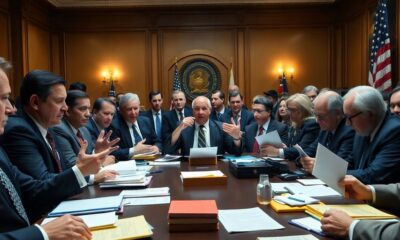Banking
US Credit Rating Downgraded by Moody’s: A Wake-Up Call for Fiscal Responsibility

Moody’s Investors Service has downgraded the United States’ credit rating from the highest possible level of Aaa to Aa1, citing escalating government debt and rising interest costs. This marks a significant shift in the financial landscape, as Moody’s is the last of the three major credit rating agencies to make this move, following similar actions by Standard & Poor’s and Fitch.
Key Takeaways
- Moody’s downgraded the U.S. credit rating from Aaa to Aa1 due to rising debt concerns.
- The downgrade reflects a decade-long increase in government debt and interest payment ratios.
- Federal deficits are projected to widen significantly, reaching nearly 9% of GDP by 2035.
- The downgrade could lead to higher borrowing costs and impact investor sentiment towards U.S. assets.
Reasons Behind The Downgrade
Moody’s cited several key factors for the downgrade:
- Rising Debt Levels: The U.S. federal debt has surged to approximately $36 trillion, with projections indicating it could reach 134% of GDP by 2035.
- Interest Payment Burden: Interest payments on the debt are expected to increase significantly, driven by higher rates and more principal debt.
- Political Gridlock: Successive administrations and Congress have failed to implement effective measures to address the growing fiscal deficits, leading to a lack of confidence in future fiscal management.
Implications of The Downgrade
The downgrade is expected to have several implications for the U.S. economy and financial markets:
- Increased Borrowing Costs: Investors may demand higher yields on U.S. Treasury securities, reflecting the increased risk associated with the downgrade.
- Market Reactions: Following the announcement, yields on the benchmark 10-year Treasury note rose, and major stock indices experienced declines.
- Investor Sentiment: The downgrade could dampen sentiment towards U.S. assets, potentially leading to a shift in investment strategies.
Political Reactions
The downgrade has sparked a range of reactions from political leaders:
- Democratic Leaders: Senate Democratic Leader Chuck Schumer called the downgrade a wake-up call for Republicans to reconsider their fiscal policies, particularly regarding tax cuts that exacerbate the deficit.
- Republican Response: Some Republican leaders acknowledged the need for fiscal responsibility, emphasizing the importance of addressing the structural drivers of debt.
Future Outlook
Despite the downgrade, Moody’s maintained a stable outlook for the U.S., indicating that while the fiscal situation is concerning, the country retains significant economic strengths, including the resilience of its economy and the U.S. dollar’s status as the global reserve currency.
However, analysts warn that without credible efforts to stabilize debt levels, the U.S. may face higher borrowing costs and reduced economic flexibility in the future. The ongoing political stalemate over fiscal policy raises questions about the government’s ability to implement necessary reforms.
In conclusion, the downgrade by Moody’s serves as a critical reminder of the importance of fiscal responsibility and the need for bipartisan cooperation to address the growing challenges posed by national debt. As the U.S. navigates this new financial landscape, the focus will be on how policymakers respond to these pressing issues.
Sources
- Moody’s lowers U.S. credit rating to ‘Aa1’, CNBC.
- Moody’s downgrades US credit rating over rising debt, WUSA9.
- With Moody’s downgrade, US loses treasured Aaa credit rating, Reuters.
- US loses top triple-A credit rating after Moody’s cites debt concerns, France 24.
- Moody’s cuts America’s pristine credit rating, citing rising debt, Reuters.
-

 Blockchain Technology5 days ago
Blockchain Technology5 days agoBlockchain Beyond Cryptocurrency: 5 Game-Changing Applications You Should Know
-

 Business6 days ago
Business6 days agoStock Futures Soar as US-China Trade Talks Yield Positive Results
-

 Fitness & Wellness5 days ago
Fitness & Wellness5 days agoAre Smartwatches Worth It? The Best Wearable Tech of 2025
-

 Government6 days ago
Government6 days agoU.S. Government Intensifies Scrutiny of Social Security Notices Amid Funding Concerns
-

 Politics6 days ago
Politics6 days agoTrump’s Administration Races Against Time to Prevent Government Shutdown
-

 Child Welfare7 days ago
Child Welfare7 days agoTrump’s Controversial Refugee Policy: Afrikaners Welcomed Amid Global Ban
-

 Stock Market5 days ago
Stock Market5 days agoUS-China Tariff Truce Ignites Stock Market Rally
-

 Stock Market4 days ago
Stock Market4 days agoUS-China Tariff Agreement Fuels Stock Market Rally















